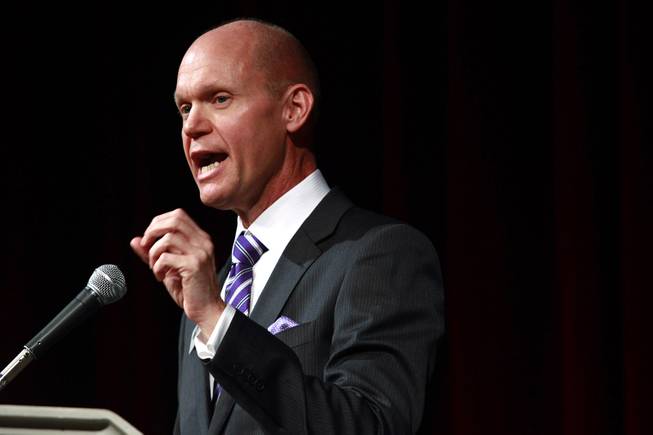
Tom Skancke speaks at the Nevada Development Authority’s annual luncheon Friday, Dec. 7, 2012.
Wednesday, Feb. 12, 2014 | 2 a.m.
Business leaders opposing a new tax initiative for education are advocating a new solution to Las Vegas’ school funding woes: Change the state’s K-12 funding formula.
Tom Skancke, the president and CEO of the Las Vegas Global Economic Alliance, argued on Tuesday that instead of raising taxes on businesses, policymakers ought to look at changing the state’s 47-year-old law governing how it distributes funding to schools.
“We’re fixing the wrong problem,” Skancke said, addressing 400 business leaders at an LVGEA luncheon. “We don’t need any more taxes. We’ve got to get our laws into the 21st century. This formula is broken.”
Skancke’s comments have ignited a debate over how Clark County can bolster its per-pupil funding, which ranks 49th nationally, according to Education Week. Nevada spends on average $8,454 per student, which is about $3,000 less than the national average, according to the magazine.
Teachers union leaders, who back the business tax, argue the school funding pie must be enlarged to benefit Clark County students.
Business leaders, who oppose the tax, are now beginning to argue that the school funding pie must be divvied up in a way that benefits Clark County students.
The state’s K-12 funding formula, called the “Nevada Plan,” was adopted in 1967 and has long been criticized for shortchanging Southern Nevada schools to the benefit of rural schools in the north.
In 2011, Esmeralda County received $17,508 per student while Clark County received only $5,068 per student.
“We’re dealing with an archaic funding system,” Clark County Schools Superintendent Pat Skorkowsky said. “The funding system has to change.”
After listening to Skorkowsky’s keynote address at the LVGEA luncheon on Tuesday, Skancke reiterated his group’s staunch opposition to the Education Initiative, a ballot measure that would impose a 2 percent margins tax on Nevada corporations making more than $1 million in revenue a year.
Proponents of the tax — primarily teachers union leaders — estimate it would raise $800 million a year in additional funding for Nevada schools.
Skancke argued the new tax revenue isn’t guaranteed to be earmarked for schools, especially if the funding formula isn’t changed.
“If the margins tax should pass — and it shouldn’t — there’s no guarantee that the funding amount to Esmeralda County will go down,” Skancke said. “There’s no guarantee that money will come here.”
Further, business leaders like Skancke fear that the new tax, which could be levied on businesses operating in the red, would stifle the state’s economic recovery.
“It’s bad tax policy,” Cara Roberts, spokeswoman for the Las Vegas Metro Chamber of Commerce, said about the margins tax.
Las Vegas business groups are now lobbying state lawmakers studying the funding formula to change it and bring more education dollars to Southern Nevada.
While business groups advocate for Clark County’s “fair share” of school funding, Nevada State Education Association President Ruben Murillo argued it isn’t enough to divide the funding pie differently.
The size of the pie needs to increase so as not to hurt Northern Nevada districts, Murillo said. The Education Initiative is the only solution that seeks to raise more money to boost school funding statewide, he said.
“Just divvying up a dried-up funding pie isn’t the solution for Nevada,” Murillo said. “We don’t want to be robbing Peter to pay Paul.”

Join the Discussion:
Check this out for a full explanation of our conversion to the LiveFyre commenting system and instructions on how to sign up for an account.
Full comments policy